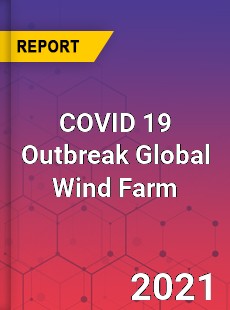
COVID-19 Outbreak-Global Wind Farm Industry Market Report-Development Trends, Threats, Opportunities and Competitive Landscape in 2020
The Global Wind Farm Market investigation report contains Types, Application & all logical and factual briefs about market 2020 Overview, CAGR, Production Volume, Sales, Revenue with the regional analysis covers North America, Europe, Asia-Pacific, South America, Middle East & Africa & The top Players like {playerNamesStr}
Exclusive deal : 20% Instant discount on Direct purchases! Don't wait—claim your discount today!
The
Key Companies Operating in
The report provides an insightful view into the detailed strategic profiles of some of the top players stirring competition in the
As well as their business strategies and company segmentations. This data is analyzed using SWOT analysis and other techniques in order to offer an educated opinion on the status of the market, to encourage the adoption of an optimal development plan for any company, or to provide insight into the
The
North America (United States, Canada and Mexico)
Europe (Germany, France, United Kingdom, Russia, Italy, and Rest of Europe)
Asia-Pacific (China, Japan, Korea, India, Southeast Asia, and Australia)
South America (Brazil, Argentina, Colombia, and Rest of South America)
Middle East & Africa (Saudi Arabia, UAE, Egypt, South Africa, and Rest of the Middle East & Africa)
The research provides the most up-to-date competitive data as well as practical guidance for companies and other clientele interested in entering the global or regional market.
Major Highlights of
The company profile section of
Understand and respond to
Latest developments of
Potential investments and merger & acquisition targets set by giants in
Highlighting key financial ratio and metrics of public and private companies of
To add value to product and services;
- 1.1 Research Objective
- 1.2 Scope of the Study
- 1.3 Definition
- 1.4 Assumptions & Limitations
Chapter 2: Executive Summary
- 2.1 Market Snapshot
Chapter 3: Market Dynamics Analysis and Trends
- 3.1 Market Dynamics
- 3.1.1 Market Growth Drivers
- 3.1.2 Market Restraints
- 3.1.3 Available Market Opportunities
- 3.1.4 Influencing Trends
Chapter 4: Market Factor Analysis
- 4.1 Porter’s Five Forces Analysis
- 4.2 Bargaining power of suppliers
- 4.3 Bargaining power of buyers
- 4.4 Threat of substitute
- 4.5 Threat of new entrants
- 4.6 Porter's Five Forces Analysis
- 4.7 Value Chain Analysis
- 4.8 Market Impact Analysis
- 4.9 Regional Impact
- 4.10 Pricing Analysis
- 4.11 Import-Export Analysis
Chapter 5: Competitive Landscape
- 5.1 Company Market Share/Positioning Analysis
- 5.2 Key Strategies Adopted by Players
- 5.3 Vendor Landscape
- 5.3.1 List of Suppliers
- 5.3.2 List of Buyers
Chapter 6: Wind Farm Market By Region
- 6.1 Overview
Chapter 7: Analyst Viewpoint and Conclusion
- 7.1 Recommendations and Concluding Analysis
- 7.2 Potential Market Strategies
Chapter 8: RESEARCH METHODOLOGY
- 8.1 Overview
- 8.2 Data Mining
- 8.3 Secondary Research
- 8.4 Primary Research
- 8.4.1 Primary Interviews and Information Gathering Process
- 8.4.2 Breakdown of Primary Respondents
- 8.5 Forecasting Model
- 8.6 Market Size Estimation
- 8.6.1 Bottom-Up Approach
- 8.6.2 Top-Down Approach
- 8.7 Data Triangulation
- 8.8 Validation
Research Methodology:
Wind Farm Market Size Estimation
To estimate market size and trends, we use a combination of top-down and bottom-up methods. This allows us to evaluate the market from various perspectives—by company, region, product type, and end users.
Our estimates are based on actual sales data, excluding any discounts. Segment breakdowns and market shares are calculated using weighted averages based on usage rates and average prices. Regional insights are determined by how widely a product or service is adopted in each area.
Key companies are identified through secondary sources like industry reports and company filings. We then verify revenue estimates and other key data points through primary research, including interviews with industry experts, company executives, and decision-makers.
We take into account all relevant factors that could influence the market and validate our findings with real-world input. Our final insights combine both qualitative and quantitative data to provide a well-rounded view. Please note, these estimates do not account for unexpected changes such as inflation, economic downturns, or policy shifts.
Data Source
Secondary Sources
This study draws on a wide range of secondary sources, including press releases, annual reports, non-profit organizations, industry associations, government agencies, and customs data. We also referred to reputable databases and directories such as Bloomberg, Wind Info, Hoovers, Factiva, Trading Economics, Statista, and others. Additional references include investor presentations, company filings (e.g., SEC), economic data, and documents from regulatory and industry bodies.
These sources were used to gather technical and market-focused insights, identify key players, analyze market segmentation and classification, and track major trends and developments across industries.
| Market Size |
|
|
| Market Position of Top Company |
|
|
| Qualitative Analysis |
|
|
Primary Sources
As part of our primary research, we interviewed a variety of stakeholders from both the supply and demand sides to gather valuable qualitative and quantitative insights.
On the supply side, we spoke with product manufacturers, competitors, industry experts, research institutions, distributors, traders, and raw material suppliers. On the demand side, we engaged with business leaders, marketing and sales heads, technology and innovation directors, supply chain executives, and end users across key organizations.
These conversations helped us better understand market segmentation, pricing, applications, leading players, supply chains, demand trends, industry outlook, and key market dynamics—including risks, opportunities, barriers, and strategic developments.
Key Data Information from Primary Sources
| Primary Sources | Parameters | Key Data |
| Market Segments(by Application, by Type) |
|
|
| Total Market |
|
|
